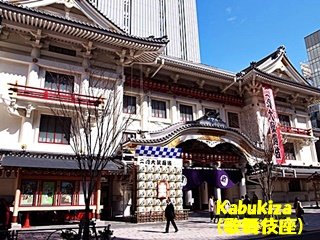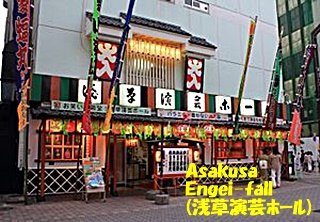Travel like "Isemairi" going to Ise Shrine on behalf of the group of neiboughs
might be the top of amusement in Edo Period, but Government strictly controls
travel to outside Edo, it was not for every people, though gradually control
became loose and later Edo Period, even tour to spa was popular among public.
Apart from travel, more common recreation for people were activities inside
Edo area, as Kabuki, Rakugo(Comic story telling), Sumo-Wrestling and etcetra.
I would like to first write about Kabuki, Nogaku, Yose(Rakugo), Bunraku
(Pappet) and Sumo, refering to the map relating to this subject;
江戸時代の人々が楽しんだ娯楽で、今でも残されているものを取り上げて
ご紹介したいと思います。 ”旅”は基本禁止だったようですが、伊勢参り等
宗教的なものはOKで次第に管理も緩み、温泉旅行なども行われたようだが、
ここでは旅を除いた娯楽をとり上げます。 第一部は歌舞伎・新歌舞伎、
能楽、寄席ー落語、文楽、相撲等で大体の場所を地図で示しておきます。
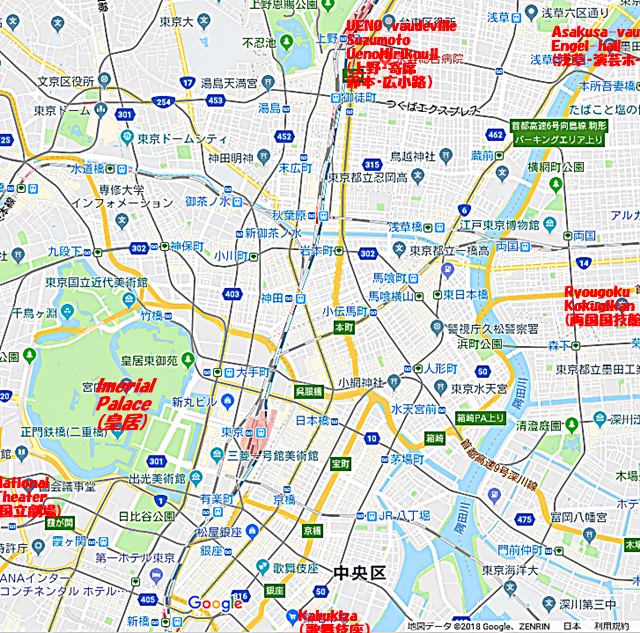
Kabuki
You may consider Kabuki as the Japanese Opera, designaed as intangible
cultural assets. Kabikiza at Ginza or Sinbashi-Enbujyou which mostly play
modern Kabuki are places to enjoy performance. Especially Kabukiza is directly
connected with subway Higashi-Ginza station for easy access. At ceiling 4th
floor gallery, only one-act ticket of 1000~1500yen is available. Also
you can see the subtitle video in English even at ceiling seats.
At Shinbashi enbujyho, most performance is so called Super-Kabuki, which are
newly written modern kabuki.
歌舞伎
伝統芸能の一つで、無形文化遺財に指定されている。銀座の歌舞伎座と
新橋演舞場が観劇し易いでしょう。 特に歌舞伎座は地下鉄の東銀座駅と
直結しており、観光客用に、天井桟敷の4階ですが、一幕のみの1000円~
1500円程度の椅子又は立見席が当日売のみですが用意されており、解説の
ビデオも英語版が提供されています。新橋の方は主にスーパー歌舞伎等を
演じています。
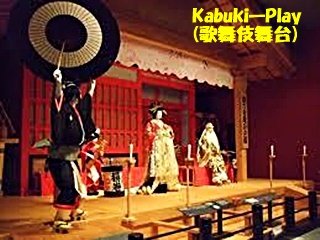
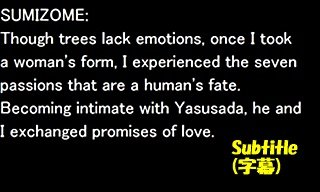
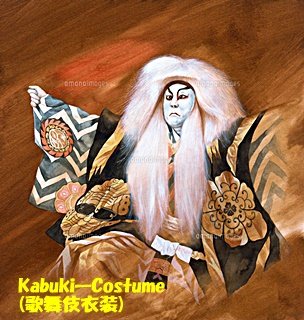
Nougaku
Nougaku includes mistelic and sophiscated "Nou" and comedic "Kyougen" and in
Tokyo, you can observe performance only at either Nogakudou, near the Olympic
Stadium or the National Theater near the house of parliament. You have to
check the performance dates as they are irregular and seats are limited.
Ticket of one-act as Kabuki is probably 2000~3000yen according to the length of
performance, and also is sold on the performance dat at the theater ticket
counter. At the seat, subtitle video in English is available.
能舞台
中央線千駄ヶ谷駅(オリンピック会場と同じ)から5分。 不定期に定例公演・
企画公演等が行われています。 観劇は2000~3000円程度で、席に英語の字幕
ガイドが設置されています。 江戸期は猿楽と呼ばれたが、明治以降狂言と
合わせて能楽と呼ばれ無形文化遺産に指定されている。能は超自然を扱う高尚な
歌舞劇で、禅と同様武士階級に支持された。
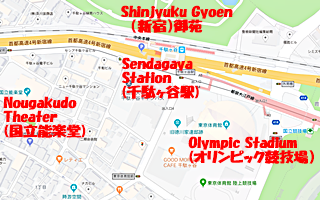
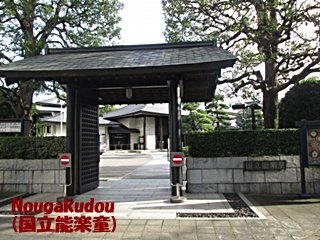
Rakugo(Comic story) at Yose(vaudeville)
Rakugo or Yose has been one of the popular amusement among public since Edo
Period. Rakugo is comical story telling by masters, talking various characters
by themselves, in comic tales. You can enjoy Rakugo, Manzai(comic dialogue),
magic and so forth at Yose halls. Yose halls are in Asakusa-Entertainment Hall,
in Ueno-Suzumoto and Hirokouji, in Shinjyuku-Suehirotei and in Ikebukuro-Engei
hall, also National theater occasionally offers Rakugo.
落語(寄席)
庶民の芸能として江戸時代に成立、現在も漫才・奇術等と共に”寄席”他で
演じられる。寄席は下町、浅草・上野にあり、一部池袋・新宿にもある。
歌舞伎や能楽と違って衣装に頼らず、噺の何役をも一人で演じ分ける話芸である。
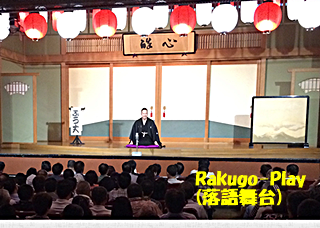
4)National theater (especially Bunraku-pappet)
Near the House of Parliament, there is the National Theater for performance of
the Japanese traditional arts as Kabuki, Nougaku, Rakugo and etcetra. Bunraku,
Japanese pappet can be seen probably only here in Tokyo. You have to check the
schedule as performance of each day changes. Location of the theater is shown
on the map and the nearest way is from Nagatacho Station of subway. One-act
ticket of Bunraku is available on the day of performance, similar to Kabuki,
which is 1000 yen if performance time is one hour, though the number of the
seats is limited.
国立劇場(特に文楽)
千代田区の国立劇場で、歌舞伎・文楽・落語の他、伝統芸能に関する情報が
提供されています。 有楽町線永田町駅又は半蔵門線半蔵門駅から10分以内の
距離です。 文楽は特別な劇場で、年に数週間単位で数回行われます。
歌舞伎座と同様当日券のみ、一幕のみのチケットが1時間もの1000円程度で、
座席数に限りがありますが提供されています。
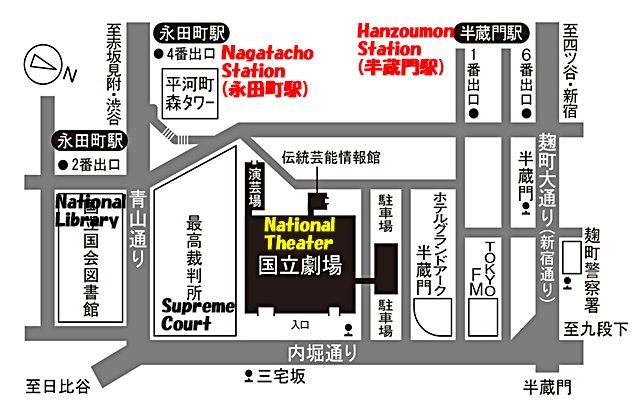

5)Sumou-wrestling: Kokugikan
Ryougoku-Kokugikan is the mecca of Sumou, located at Ryougoku station of JR
Soubu Line. Light green roof is the feature of the building and inside there
is the "Dohyou-ring" at the center of stadium, surrounde by Masu seats(4 seats
of tatami) and individual seats.
Usually, games are held in January, May and September while in other months,
they go to local cities for performances. In the last row, individual seats
are sold at 2200 yen, at stadium ticket place on the game day.
Game starts about 9 o'clock in the morning, and junior game starts two o'clock
and the top rank games starts three-thirty every day.
相撲‐国技館
両国国技館は相撲のメッカです。 隅田川東岸、JR総武線両国駅前にあり、
緑の屋根が特徴です。 1月・5月・9月に東京場所があり、最後部の椅子席が、
当日券のみだが2200円で提供される。 場所のある日は通常朝9時前から
始まるが、十両の取り組みが午後2時頃から、幕内は3時半からで、終了は
午後6時の予定である。
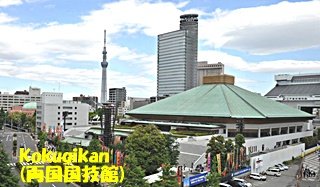
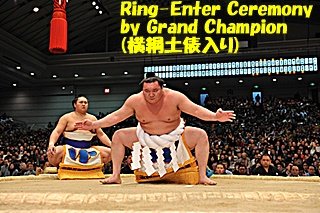
To be continued to the next post, Amusement -2.
今回はここまで、次の号で更に別の娯楽を取り上げたいと思います。
